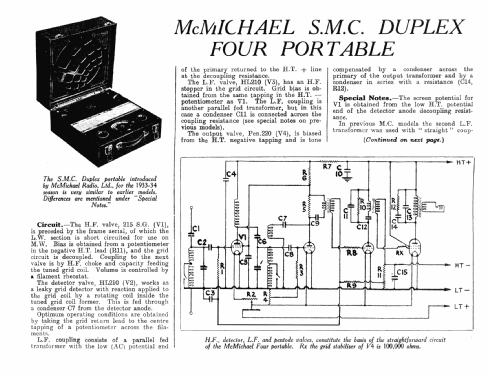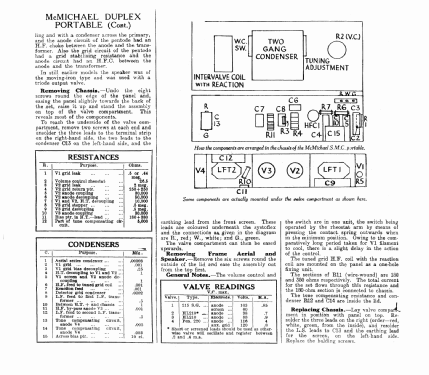Duplex four SMC early
McMichael Radio Ltd.; Slough
- Country
- Great Britain (UK)
- Manufacturer / Brand
- McMichael Radio Ltd.; Slough
- Year
- 1933/1934
- Category
- Broadcast Receiver - or past WW2 Tuner
- Radiomuseum.org ID
- 178620
-
- alternative name: McMichael, Leslie
Click on the schematic thumbnail to request the schematic as a free document.
- Number of Tubes
- 4
- Main principle
- TRF with regeneration; 2 AF stage(s)
- Tuned circuits
- 2 AM circuit(s)
- Wave bands
- Broadcast (MW) and Long Wave.
- Power type and voltage
- Storage and/or dry batteries / 2 & 126 Volt
- Loudspeaker
- Permanent Magnet Dynamic (PDyn) Loudspeaker (moving coil) / Ø 5 inch = 12.7 cm
- Power out
- 0.3 W (unknown quality)
- Material
- Leather / canvas / plastic - over other material
- from Radiomuseum.org
- Model: Duplex four SMC [early] - McMichael Radio Ltd.; Slough
- Shape
- Portable set > 8 inch (also usable without mains)
- Dimensions (WHD)
- 390 x 220 x 380 mm / 15.4 x 8.7 x 15 inch
- Notes
- The early model SMC has a manual volume control by means of a variable filament current for the RF stage, while the late model used to vary the RF stage grid bias.
This is a leathercovered suitcase model. The lid of the case contains the frame aerial and the loudspeaker.
- Net weight (2.2 lb = 1 kg)
- 13 kg / 28 lb 10.1 oz (28.634 lb)
- Mentioned in
- Radio! Radio! (p.127, fig.368)
- Literature/Schematics (1)
- Hardware analysis.
- Author
- Model page created by Konrad Birkner † 12.08.2014. See "Data change" for further contributors.
- Other Models
-
Here you find 183 models, 123 with images and 120 with schematics for wireless sets etc. In French: TSF for Télégraphie sans fil.
All listed radios etc. from McMichael Radio Ltd.; Slough
Forum contributions about this model: McMichael Radio Ltd.: Duplex four SMC
Threads: 1 | Posts: 1
There is an early version applying manual gain control by means of filament variation in the RF stage.
This was state of the art for battery triodes in the late 1920's.
But now the RF triode was replaced by a superior screen grid valve. Such a valve is behaving different to filament variations, in particular at low emission for low gain, where the setting is rather unstable.
Obviously led this drawback to a redesign of the volume control by leaving the filament on full supply while a variable grid bias was introduced. This results in an easier and smoother control function.
The available documentation describes the late version only.
The early version was on my workbench for repair. It had a low resistance rheostat (original, physically identical with the high resistance potentiometer in the late version) but some "repair" attempts of previous owners left a chaos: senseless resoldered wires, wrongly connected on-off-switch etc.
He must have desperately decided to sell the spoiled thing after replacing two original Audios by defect ones (different brands; all 4 windings open), putting four valves with open filament. The next owner (in Germany) could not do much better and sold it again.
Now the buyer asked me for help.
I can proudly report that the radio is back to life now (after spending about 3 days to navigate through the wiring jungle and the wrong map (schematic)...
Konrad Birkner † 12.08.2014, 20.Jul.10

